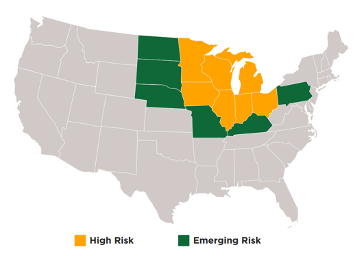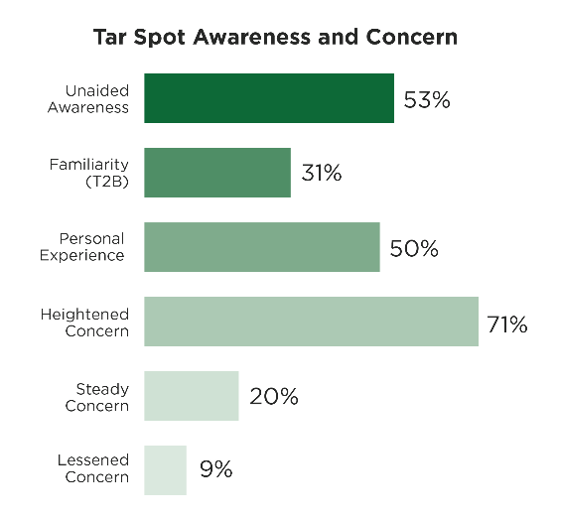SURVEY SHOWS TAR SPOT HAS COMMANDED FARMERS’ ATTENTION
SURVEY SHOWS TAR SPOT HAS COMMANDED FARMERS’ ATTENTION

Tar spot continues its march across the Midwest, with the telltale black specks putting more and more farmers on high alert. A new survey1 confirms tar spot has their full attention.
Over half of the nearly 400 farmers surveyed this October cited tar spot when asked about diseases that may impact corn in their area, with one-third of the respondents naming tar spot first. Commissioned by AgReliant Genetics and conducted by Kynetec, survey findings were unveiled at AgReliant Genetics’ premiere Tar Spot Summit.
Farmers’ tar spot concern eclipses worry about other diseases like northern corn leaf blight, southern rust and Goss’s wilt, especially in states where tar spot is prevalent like Minnesota, Iowa, Wisconsin, Illinois, Michigan, Indiana and Ohio. Fifty-six percent of the farmers in these high-risk states are very or extremely concerned about the disease, distantly followed by northern corn leaf blight at 28%.
While concern about tar spot is high, survey results indicate farmers lack clear direction on how to manage the disease. “I found the level of farmer uncertainty regarding some of the foundational concepts about tar spot and how to manage it striking, even in areas where the tar spot is prevalent,” says Whitney Monin, national agronomy manager at AgriGold.
“I think my agronomy team will be equally surprised by the results. We sometimes assume farmers know about tar spot, forgetting that they are managing huge enterprises. The results drive home the importance of asking the right discovery questions and reminding farmers it’s OK not to know when working to generate understanding about tar spot and how to manage it.”
DRYNESS LIMITED TAR SPOT’S YIELD IMPACT IN 2022, BUT FARMERS REMAIN ANXIOUS
Despite a relatively dry growing season in 2022 that limited tar spot’s impact, 71% of the farmers surveyed expressed heightened concern about the disease, primarily due to its rapid spread.
Half of the respondents had detected tar spot on their land at least once, with 90% of those hit by tar spot experiencing yield loss. The late arrival of the disease limited its impact on yields in 2022. However, the mean percentage of acres impacted across years of grower experience was high at 40%, signaling the potential for a major outbreak if the 2023 growing season is wetter.
“Tar spot is a complex disease that spreads quickly and can have a devastating impact when the environment is right for the disease, as we saw in 2018,” Monin says. “Pinpointing the environmental predicators that serve as early warning signals is a priority for the industry,” she continues.
“Once you’ve seen the spores, you’re already about two weeks behind,” Monin observes. That has driven more farmers to focus on preventing tar spot vs. managing an outbreak.
KNOWLEDGE GAP ON TAR SPOT MANAGEMENT

While farmer awareness and concern about tar spot is high, the survey also revealed uncertainty about the disease mechanism and how to manage it. A third of the respondents had a good understanding of tar spot’s yield impact. However, only 16% said they understand how it overwinters, 17% understand how it spreads or under what conditions, 13% understand hybrid tolerance or tolerance ratings, and 17% understand fungicide efficacy.
One farmer’s comment in the survey about managing the disease demonstrates that uncertainty: “We had a major outbreak in 2021. In 2022, we applied fungicide, but there was practically no incidence of this disease in our area. Now we are unsure if it’s necessary to spray.”
“From an agronomic perspective, the survey reminds that we can’t make assumptions when working with farmers to develop strategies that marry their farm needs with disease management,” Monin says, adding “Tar spot is just one of many concerns on any given farm.”
Most farmers plan to use a combination of strategies to fight tar spot. The survey shows the most common tactics for combatting tar spot are:
- rotating crops (60%)
- scouting fields (48%)
- planting hybrids with high tar spot tolerance scores (47%)
Only 6% plan to do nothing to manage the disease.
“Crop rotation can limit overall infection, but tar spot spores can still spread from nearby fields,” Monin explains. “Other strategies include fungicide application(s) and choosing tar spot-tolerant hybrids that fit a farmer’s unique operation and goals,” she says. “There is no silver bullet for preventing this complex disease, but planting tolerant hybrids and applying fungicides at the right time can fortify farmers’ defense.”
“AgriGold led the industry in publishing tar spot ratings for its hybrids, helping farmers consider tar spot tolerance along with other yield and agronomic factors when selecting seed. Moving forward, my agronomy team will be focused on having open conversations with our farmer customers about tar spot and how best to fight it.”
TOLERANT HYBRIDS AN IMPORTANT TOOL FOR FIGHTING TAR SPOT
Seventy-one percent of farmers plan to plant hybrids with high tar spot-tolerance scores in 2023, a 24-point increase over the percentage currently using tolerant hybrids. The increase speaks to the rapid spread of what can be a hard-hitting disease. In addition, 55% of farmers surveyed agreed that diversifying genetics helps mitigate risk.
“A plant cannot fight a war on two fronts,” Monin says. “If your plant is already weak because it’s deficient in nitrogen or soil pH is out of whack or it’s been stressed by drought or disease, it’s more susceptible to tar spot.”
Farmers recognize they have to stay focused on the foundational principles of growing a great crop, according to Monin, who says AgriGold offers hybrids with diverse genetics that can help farmers spread risk and protect crops against a wide array of weather and disease threats, including tar spot.
REFERENCE: BELLINGER, M. AND CLYNE, D. AGRELIANT GENETICS TAR SPOT STUDY. KYNETEC. NOV. 10, 2022.
©2022 AgReliant Genetics, LLC.



